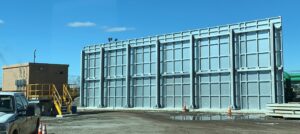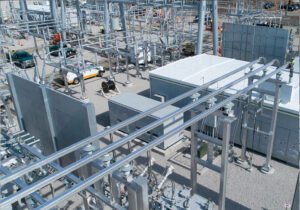In industrial settings, safety is a top priority, and one critical aspect is protecting electrical systems from fire hazards. Ensuring that cable trays are properly protected can significantly enhance overall safety. Effective fire protection measures, such as those provided by fire barrier services, help to prevent the spread of fire, minimizing damage and potential risks to both personnel and infrastructure. Understanding the importance of fire protection for cable trays is essential for maintaining a safe and secure industrial environment.
Understanding Cable Tray Systems
Cable tray systems are essential for organizing and supporting electrical cables in industrial environments. They provide a structured pathway that keeps cables secure and accessible.
Types of Cable Trays
There are various types of cable trays, including ladders, troughs, and baskets. Each type serves a specific purpose and offers unique benefits in different settings. Ladder trays have rungs that allow air circulation and prevent overheating, making them ideal for heavy-duty applications.
Trough trays provide a solid base for cables, offering more protection against physical damage. Basket trays, made of wire mesh, are lightweight and easy to install, making them suitable for many applications, including commercial buildings and data centers. Each type is designed to meet different needs and environments, ensuring that cables are well-organized and protected.
Common Materials Used
Cable trays can be made from materials like steel, aluminum, and fiberglass. The choice of material depends on factors such as environment, load capacity, and durability requirements. Steel trays are strong and can handle heavy loads, ideal for industrial settings where robustness is needed. Aluminum trays are lighter and resistant to corrosion, making them suitable for outdoor use and areas with high humidity.
Fiberglass trays are non-conductive and resist chemicals, making them perfect for harsh environments where electrical insulation and chemical resistance are important. Lastly, Sinisi Cable Trays are made out of two metal face sheets mechanically bonded to a fibre reinforced cement core making it an exceptionally robust material great for harsh industrial and outdoor environments and is resistant to fire, blast, and impact.
Fire Hazards in Cable Trays
Cable trays can become a fire hazard if not properly protected. The accumulation of dust, debris, and flammable materials can ignite and spread fire quickly. Also, it’s important that cables in hazardous areas are protected from the elements, fire, explosion, vandalism, and impact. That’s why Sinisi barriers are an ideal solution to protect cable trays and ensure continuity of critical infrastructure.
Causes of Fire in Cable Trays
Besides outside causes, fires can also happen inside cable trays themselves. Overloaded circuits, faulty wiring, and lack of maintenance are common causes of fire in cable trays. Identifying these risks is crucial for prevention. Overloaded circuits can overheat and spark, igniting surrounding materials. Faulty wiring, such as exposed or damaged wires, can create short circuits and lead to fires. Regular maintenance is essential to spot and fix these issues before they become serious hazards.
Consequences of Cable Tray Fires
Fires in cable trays can lead to severe consequences, including equipment damage, production downtime, and safety risks to workers. When a fire occurs, it can destroy expensive equipment, leading to significant financial losses. Production downtime caused by fires can disrupt operations, affecting productivity and profitability. Most importantly, fires pose a serious threat to worker safety, potentially causing injuries or even fatalities. Proper fire protection is essential to prevent these dangerous outcomes.
Importance of Fire Protection for Cable Trays
Implementing fire protection measures for cable trays is vital for industrial safety. It helps to contain and extinguish fires before they spread.
Fire-Resistant Coatings
Applying fire-resistant and intumescent coatings to cable trays can prevent the spread of flames and protect the integrity of the electrical system. These coatings form a barrier that slows down the ignition and spread of fire, providing extra time for emergency responses. This is especially important in industrial settings where quick containment can save lives and reduce damage to expensive equipment and infrastructure. Intumescent coatings will expand in the presence of fire, smothering the ability of the fire to spread.
Regulatory Standards and Compliance
Compliance with regulatory standards ensures that cable trays are properly protected against fire hazards. Adhering to these standards is essential for industrial safety.
National Fire Protection Association (NFPA)
The NFPA provides guidelines and standards for fire protection in industrial settings. Following these standards is crucial for safety and compliance. The NFPA 70 (National Electrical Code) and NFPA 75 (Standard for the Fire Protection of Information Technology Equipment) are examples of standards that address fire safety for cable trays. These guidelines help prevent electrical fires and ensure that systems are designed and maintained to minimize fire risks.
Occupational Safety and Health Administration (OSHA)
OSHA regulations mandate fire protection measures for electrical systems, including cable trays. Ensuring compliance with these regulations is vital for worker safety. OSHA standards, such as 29 CFR 1910.303, outline requirements for the safe installation and maintenance of electrical systems. These regulations aim to protect workers from fire hazards by enforcing proper fire protection practices and regular inspections of electrical equipment, including cable trays.
Best Practices for Maintaining Fire Safety
Regular maintenance and inspection of cable trays are essential for fire safety. Implementing best practices can prevent potential fire hazards.
Routine Inspections
Conducting routine inspections helps to identify and address potential fire hazards in cable trays before they become serious issues. Regular checks can spot signs of wear, damage, or faulty wiring that could lead to fires. By scheduling these inspections periodically, industries can ensure that their cable trays are always in safe working condition, reducing the risk of unexpected fire incidents.
Cleaning and Maintenance
Regular cleaning and maintenance of cable trays prevent the accumulation of flammable materials, reducing the risk of fire. Dust, debris, and other flammable substances can gather in cable trays, creating a fire hazard. By keeping the trays clean and well-maintained, industries can minimize this risk. Proper maintenance also includes checking for and repairing any damage to the trays themselves, ensuring they continue to provide safe support for electrical cables.
Ensuring Safety with Effective Fire Protection for Cable Trays
Cable Tray Fire Stopping is a critical aspect of industrial safety. By understanding the potential risks and implementing effective fire protection measures, industries can ensure a safer environment for their operations. Properly protected cable trays help to prevent the spread of fire, reducing damage and safeguarding both personnel and infrastructure. Regular maintenance, compliance with regulatory standards, and the use of fire-resistant materials are key components of an effective fire protection strategy for cable trays. By prioritizing fire safety, industries can minimize risks and maintain a secure and efficient working environment.




